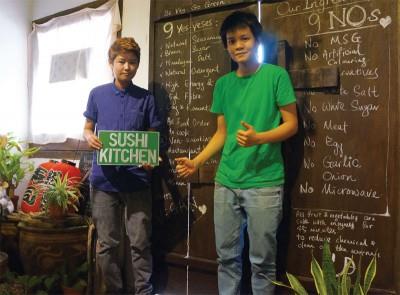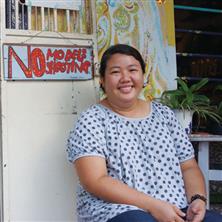Nothing ever changes in George Town, yet everything changes all the time. Old shophouses stand unchanged to face the test of time, but within them new shops and cafes pop up at a dizzying pace. A walk amidst its warren of lanes is often an exercise in fortuitous discoveries.
Foot traffic has increased significantly since the Unesco listing, helping George Town shed its ghost town image, says cafe owner Queen Lee.


Since George Town entered the Unesco World
Heritage list in 2008, its fortunes began to revive, and a chic lustre has
returned to the old town. Well-heeled investors from companies to individual
expatriates and wealthy Malaysians rushed in with plush funds to turn rundown
shops into stylish boutique hotels and elegant restaurants.
But in more recent times, young Penangites have also begun to make their mark
in George Town in their own inimitable fresh style. Giving up a regular pay
cheque for the thrill of entrepreneurship, a good number have opened their own
small businesses, reflecting just how far Penang has leapfrogged ahead in remaking
itself in the last five years.
Youth entrepreneurship has brought a new vibrancy to complement George Town’s
swish but staid heritage establishments and its old-school uncle and auntie
hawkers.
Their outlets have a distinctive brand of irreverence and fun quirkiness,
blended with daring idealism. Healthy living, environmental sustainability and
community are their ethos. They are respectful of George Town’s heritage but
are not slaves to it. Their establishments retain the soul and character of the
old shophouses but eschew period furniture and fittings. You won’t find
rosewood antiques with pearl inlays here.
“Why George Town?” I asked several young business owners who set up shop in the
last two years. Almost unanimously, they say it has the advantage of lots of
people taking to the streets – as in, using their feet to walk or pedal a
bicycle. The popularity of foot power has done wonders to boost their
visibility as their small stores have a chance to catch the eyes of meandering
pedestrians and cyclists. This, they say, has helped level out the playing
field with the wealthier establishments.
“It’s not just the tourists who walk around
but also locals who have begun walking or cycling a lot,” said Lee Siew Ching,
26, who started the Leaf Healthy House vegan restaurant with her husband two
years ago. This, she says, helped bring in new customers even when their
location on Penang Street is quiet in the evenings and weekends.
People tend to walk or cycle here, partly because it’s the easiest way to
navigate George Town’s narrow streets and lack of car parks. But there’s also a
new incentive: street murals painted in random locations, from back lanes to
temple walls.


“I think the street paintings really helped as more people started walking to look for them. Our bicycle rental business has also increased,” said Siew Ching.
Queen Lee, 36, who owns the quirky Chai Diam
Ma cafe + shop on Queen Street, agrees that foot traffic has increased
significantly since George Town’s Unesco listing and street art has become
popular. She says this has helped George Town shed its ghost town image;
previously, the streets would fall silent by 5pm as offices shut and people
leave for home in the suburbs.
Running a business is still a lot of hard work but as these young people have
shown, youth and small budgets are not real obstacles. What they lack in money
and experience, they make up for in imagination and enthusiasm.
The Leaf Healthy House
Located on Penang Street, this vegan restaurant began life as a bicycle rental
shop. Its owners – a husband-and-wife team of former reporters – found this
corner lot when scouring for a space to expand their bicycle rental business.
Siew Ching and Chiang Kee Chuan, 32, soon
found the premises far too big just to store bicycles. They felt that a vegan
restaurant could be a good complement to cycling – both are about living a
healthy and sustainable lifestyle, after all.
They created a menu of Western vegan food comprising pasta, burgers and pizzas.
It took a while before the locals grew to like it, but it was easier with
tourists. “The Australians particularly like the concept,” said Siew Ching.
To stick to their small budget, it was DIY all the way from the interior design
to the menu to cooking and managing the store. They maintain an eco-friendly
ethos by recycling, using recycled products and avoiding plastic bags. They
also give away edible plants, adding a personal touch that brings in repeat
customers.
Sushi Kitchen
Yeoh Beng Lee and Goh Hooi Cheen, both 24, learned about vegan Japanese food
when they worked at Sushi Kitchen in Sungai Ara for five years. Recipes were
adapted to eliminate meat, garlic, onions, processed rice, sugar and salt.
Five months ago, the two friends decided to branch out on their own to open a
Sushi Kitchen on Gat Lebuh Acheh. Located next to a dusty temple, amidst empty
shops and slightly off the tourist thoroughfare, they relied initially on
existing Sushi Kitchen customers. But people soon began stumbling into their
restaurant, and a new fan base was born for their homemade vegan food.
“We get people walking in when they spot our
shop or coming over because they heard about us on the Internet,” said Goh.
Armed with an RM40,000 loan, the two friends outfitted the restaurant with
handmade furniture, right down to the tatami mats and doors. The decor was a
matter of exercising their imagination and getting their hands dirty with
paint, they say.
Chai Diam Ma
Its name may be Hokkien for “sundry shop” but Chai Diam Ma on Queen Street has
decided to stick to selling handmade arts and crafts. Started by Queen two
years ago, the store has a section dedicated to handmade items by Malaysians. A
cafe fills up the rest of the premises.
It started when Queen, then a kindergarten teacher, found a dilapidated shophouse
available for a low rent. With just RM5,000 in her bank account, she asked
friends to donate old furniture which she refurbished and made her own
decorations from items as diverse as egg cartons and spoons. It was upcycling
at its best, in keeping with the ethos of sustainability.
She has since started another shop selling children’s books. Youth, she says,
is the best time to start a business as she can return to full-time work, if
necessary.
A winning formula
George Town appears to have hit on a winning formula in attracting the young
into this risky, if heady, world of business. The town area is small and
walkable, and it has a wealth of evocative shophouses that fit well into the
ethos of youth-run businesses.
Although they confess that running a business has been a lot harder than they
anticipated, these energetic people also feel that they have a chance to
succeed in George Town. It’s a place where their youthful brand can thrive. The
old city is still young at heart.
Carolyn Hong is a journalist who spent her
days racing to keep up with Malaysia as it changes at a breakneck pace over the
last few years. Now she is on a slow journey to explore its little corners
especially in Sabah and Sarawak.
Source : Story reproduced with permission from Penang Monthly.